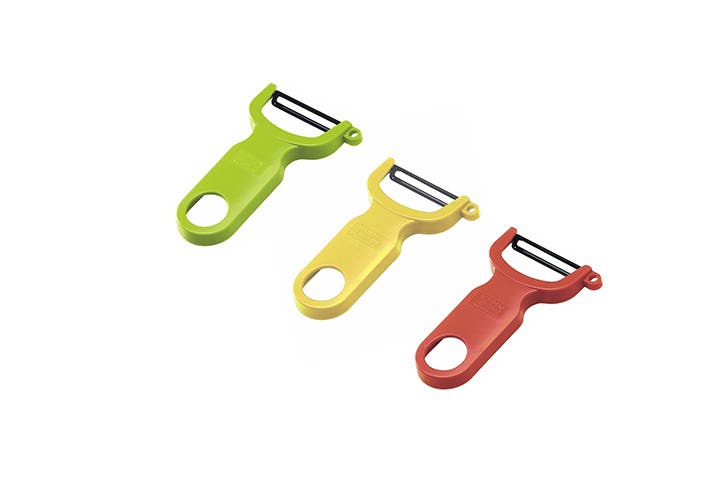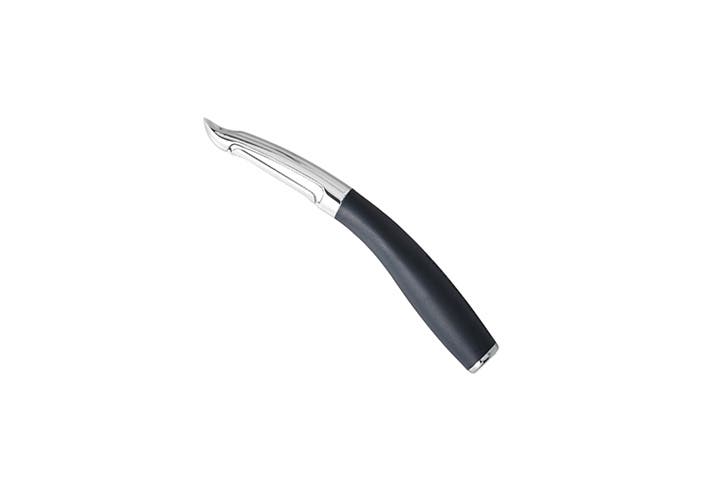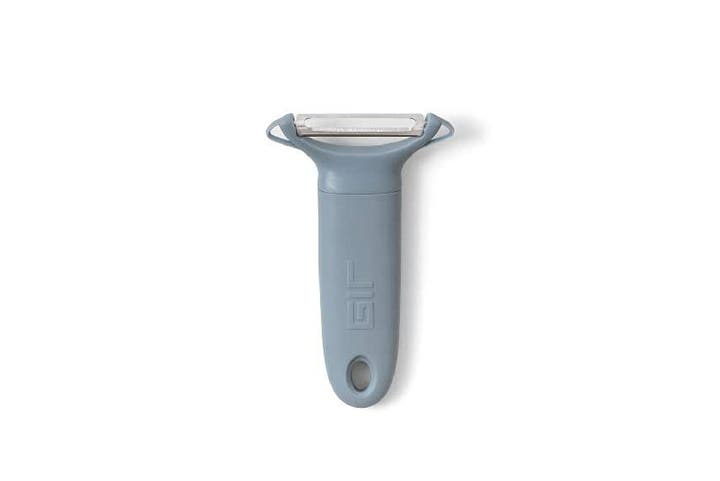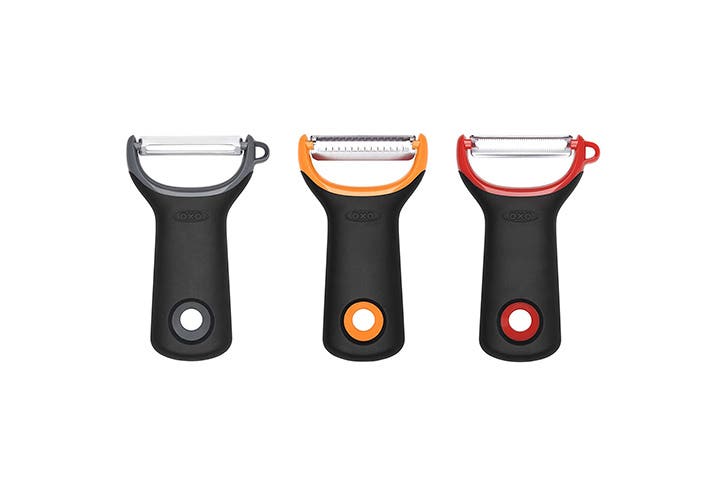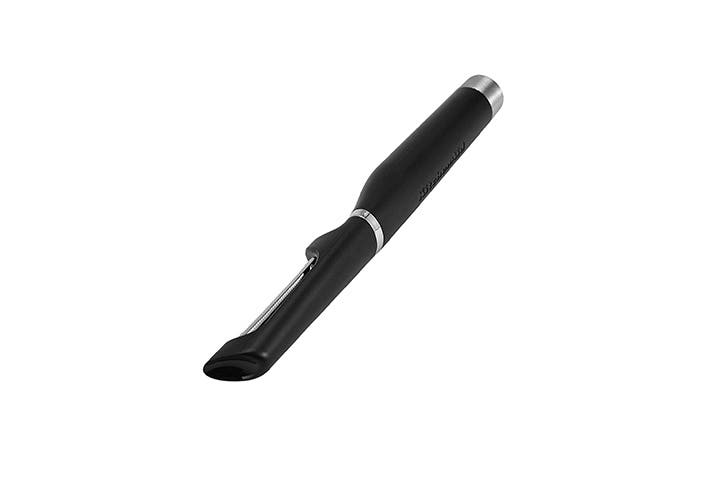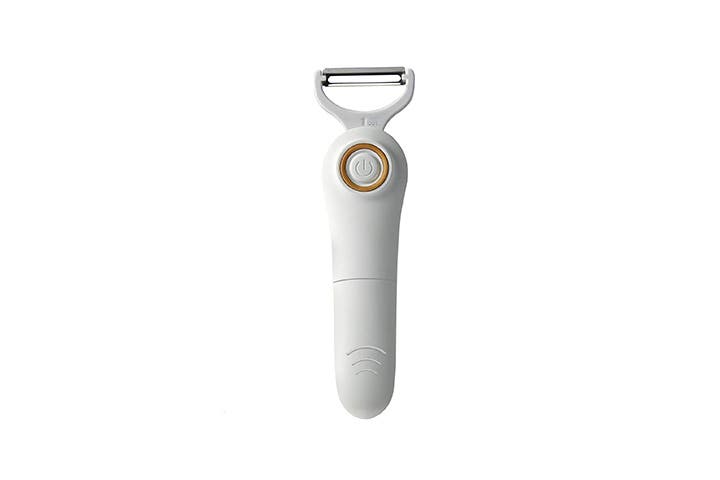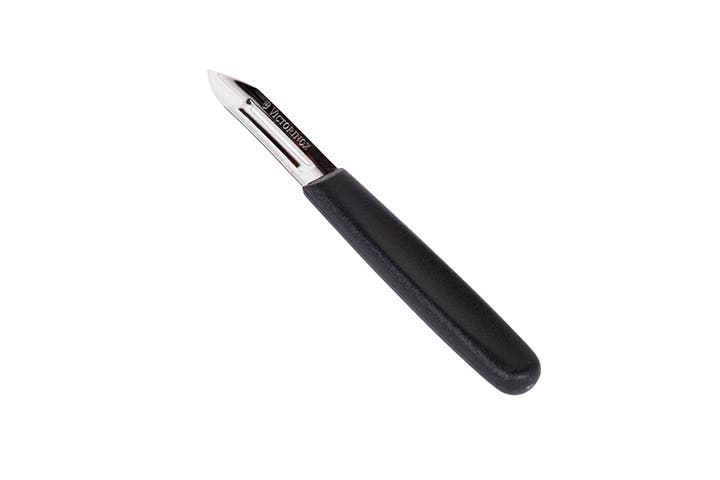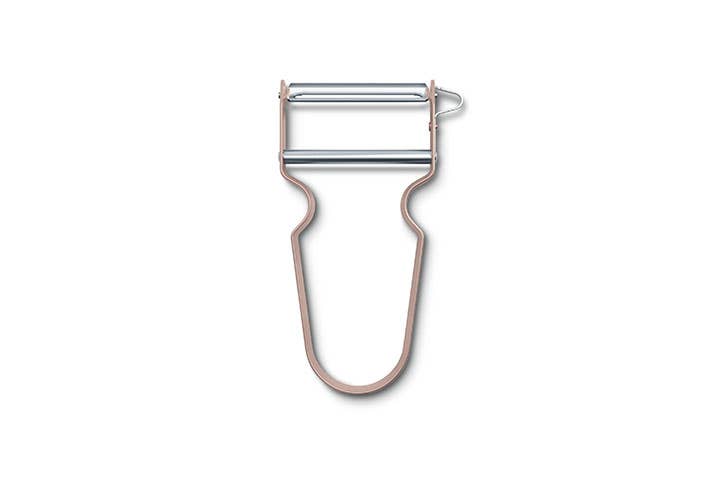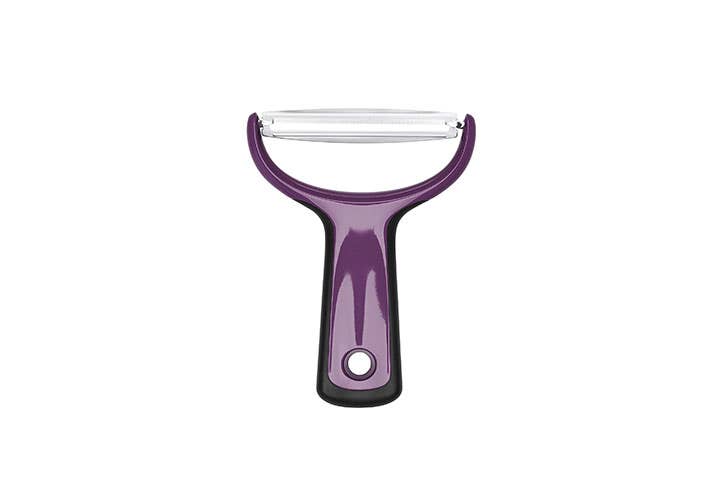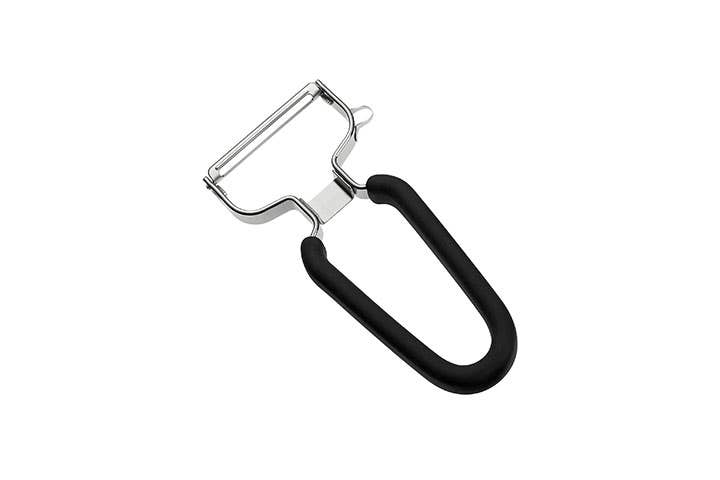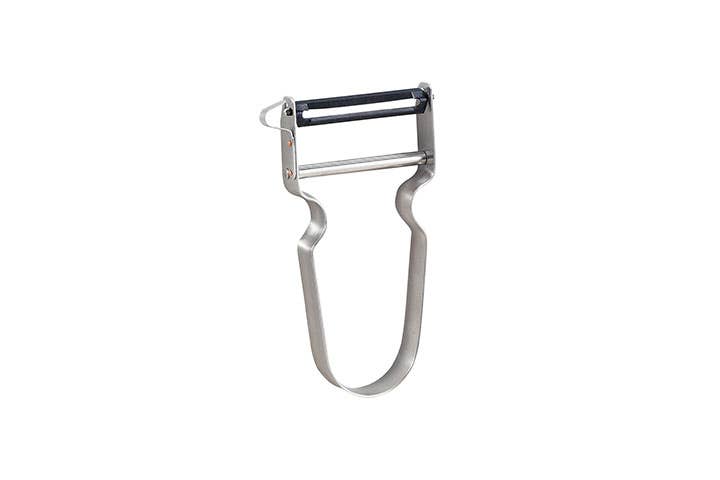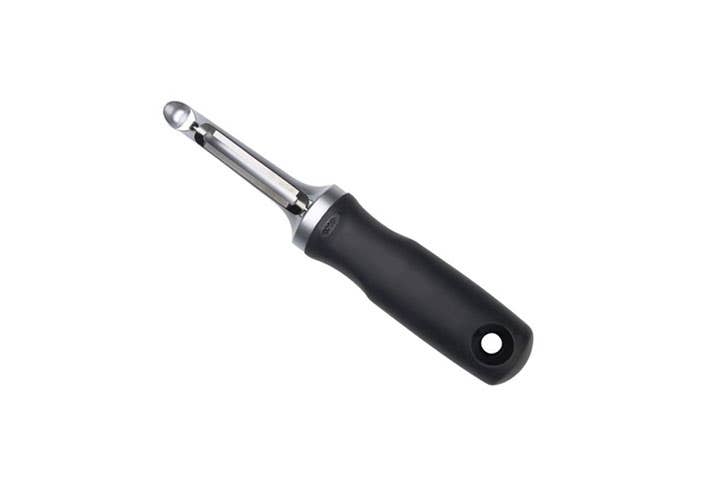We Sliced Through Bags of Produce to Find the Best Vegetable Peelers
These must-have kitchen tools are low cost and high reward.
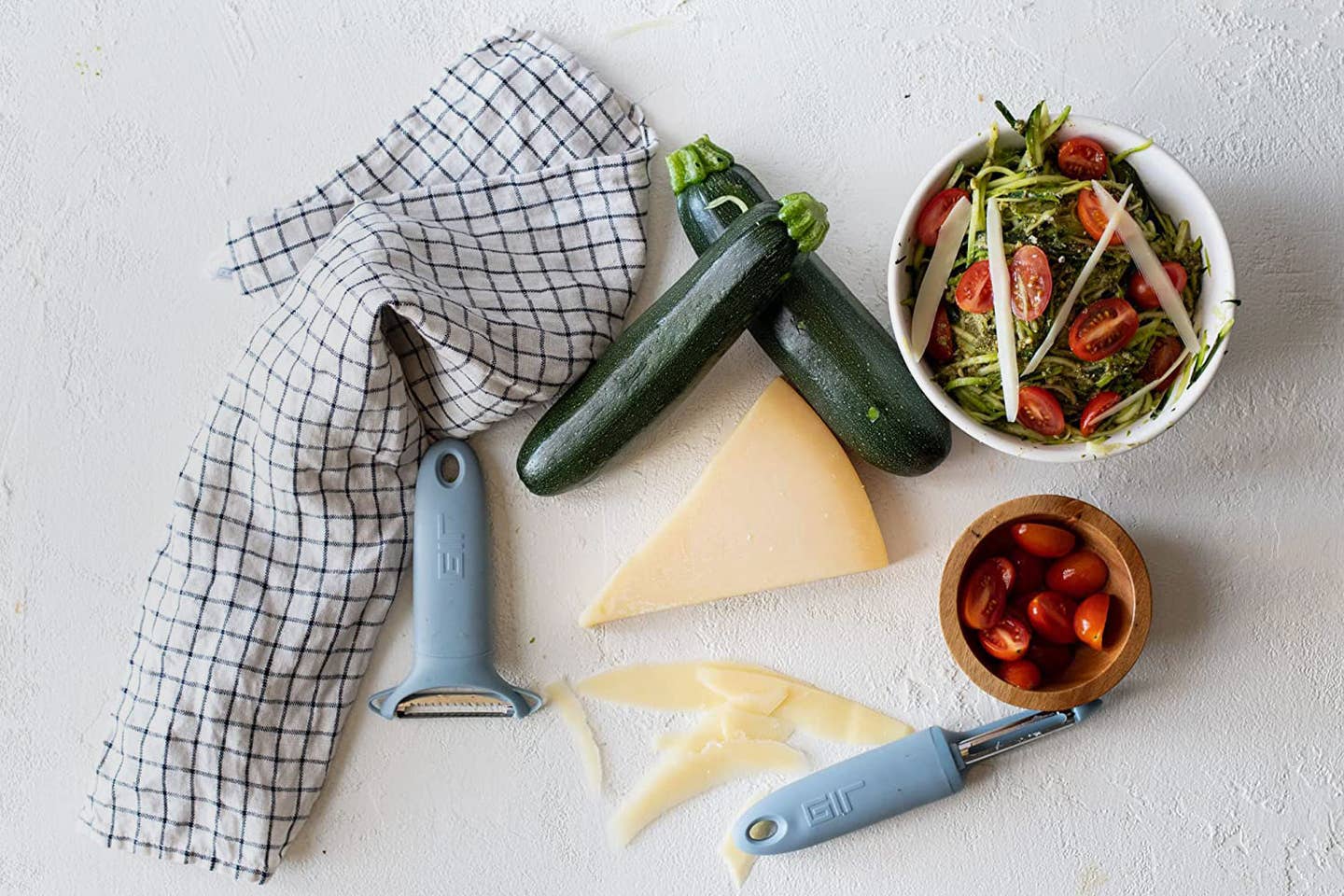
It’s time to leave behind memories of being stuck at the kitchen sink with a a mountain-sized bag of potatoes and a cramping hand, the result of low-quality peelers that just don’t cut it. And while often considered a single-use tool, the best vegetable peelers will come in handy on more than one occasion—preparing a slaw? apples for pie? garnishing a cocktail with a citrus rind? These steel blades should be able to thinly slice through hard root vegetables, and earn extra points for offering curated carves of citrus, fruit skins, and neater chunks of cheeses like Parmesan. If we convinced you to make an upgrade, check out our favorite peelers that we rounded up and tested below—prioritizing a balance of sharpness, comfort, and durability—to easily elevate your at-home cooking or baking experience.
Our Top Picks
- Best Y-Shape: Kuhn Rikon Original Peeler
- Best I-Shape: Williams Sonoma Straight Swivel Peeler
- Best Value: GIR Premium Swivel Y-Peeler
- Best Set: OXO Grips Assorted Peelers
- Best Serrated: KitchenAid Gourmet Euro Peeler
- Best Electric: Electric Handheld Vegetable Peeler
- Best Basic: Victorinox Universal Vegetable Peeler
Best Y-Shape: Kuhn Rikon Original Peeler
Best Y-Shape
Blade type: Straight | Weight: 0.7 ounces | Dominant hand: Ambidextrous | Dishwasher-safe: No
Pros
- Carbon steel blade
- Subtle blemish remover
Cons
- Rusts easily
Why we chose it: Lightweight and sharp, it’s available at a price point that can’t be beat—what more could you ask for?
Ask any professional chef or cooking enthusiast what vegetable peeler they have at home and we’d bet nine times out of ten it’s this Swiss brand’s classic model. Despite the small size, the swivel blade easily maneuvers over all sorts of curvy exteriors, producing a consistently thin slice. Although sold as a three-pack, all of the blades are the same, the only thing that differs is the fun colors. Because these peelers are so feather light, you’ll need to apply a bit more pressure to retain smoothness with root vegetables, but otherwise they will refuse to get caught on any bumps along the way. Pro tip: Although the company notes this item is dishwasher safe, we’d advise against it. Give this a quick hand-wash and dry immediately as carbon steel, though incredibly sharp, rusts quickly.
Best I-Shape: Williams Sonoma Straight Swivel Peeler
Best I-Shape
Blade type: Straight | Weight: 4.4 ounces | Dominant hand: Ambidextrous | Dishwasher-safe: Yes
Pros
- Easy to use
- Non-slip handle
- Lovely color range, including a purple lilac and pink geranium
Cons
- Priciest on the list
- Exclusive to Williams Sonoma
Why we chose it: A luxurious, unconventional upgrade to a mundane shape.
Initially intimidated by the hefty feel, this peeler proved its weighty sturdiness wasn’t without reason. The stainless steel blade smoothly glides without much effort needed (we’d imagine this would be a great fit for users with arthritis or carpal tunnel). In fact, if you do press too hard, it can easily take off a deeper chunk than intended if your primary goal is to simply remove the skin. However strong, we argue its standout feature is the custom, curved handle encased with a cushy, silicone-like substance that offers superior comfort—a bag of sweet potatoes and carrots later and our testers still felt no stiffness or soreness. Plus, the larger, 2.5-inch blade helped cut back on time.
Best Value: GIR Premium Swivel Y-Peeler
Best Value
Blade type: Straight | Weight: 2.4 ounces | Dominant hand: Ambidextrous | Dishwasher-safe: Yes
Pros
- Oven-, microwave-, and dishwasher-safe
- Choose between a straight or julienne style
- Blemish removers on both sides
Cons
- Silicone base that’s a little slippery when wet
Why we chose it: For less than $10, this peeler is a solid choice.
If you’re sick of having to slice ingredients in one back-to-font motion, this particular peeler is fine making cuts from any angle with ease—front to back, or side to side, the stainless steel blade never has to be lifted to make a new cut. While it took to carrots and sweet potatoes without any trouble, we bet this would do better on vegetables with an even greater surface area, like butternut squashes. And while comfortable to hold, the silicone—which comes in a few fun, bright colors—had a tendency to get slippery when wet, though not bad enough to remove it from our list of favorites, unlike some others that are only a steel handle. It’s also bigger than expected, tallying in at 5.3 inches by 3.5 inches (the width of the head).
Best Set
Blade type: Varied | Weight: 1.3 Ounces | Dominant hand: Ambidextrous | Dishwasher-safe: Yes
Pros
- Japanese-made blades that resist rust
- Compact size (easier to store all three together)
- Non-slip grip
Cons
- Too small for larger vegetables (i.e. we’d pass on using these for zoodle making)
Why we chose it: Not sure if you want a straight, serrated, or julienne peeler? This set gives you all three for $15.
About the same size as the Kuhn Rikon Y-peelers (albeit the slightest bit heavier), this pick is for those who see themselves peeling a variety of surfaces on the regular. A lot of the peelers we picked are able to handle multiple surfaces, even if it’s a straight blade, but the serrated edges offer a greater advantage for slick surfaces like tomato skin. But be careful: if you’re trying to fly through your peeling prep, your fingers can easily get nicked in the process.
Best Serrated: KitchenAid Gourmet Euro Peeler
Best Serrated
Blade type: Serrated | Weight: 3.9 Ounces | Dominant hand: Ambidextrous | Dishwasher-safe: Yes
Pros
- Effortlessly efficient
- Plastic blade guard
Cons
- Long (but slim)
Why we chose it: A double-edge serrated peeler that slices through anything and everything with ease.
Anything you place in this peeler's way is sure to be sliced through with minimal resistance (actually like cutting through butter). A perfect balance between not too light and not too heavy, it’s easy to control, and despite its grippy, serrated teeth (which are great for fruit and citrus exteriors), it makes paper-thin cuts, adding to its multi-purpose appeal. You can tap this peeler for artfully curated salads, preparing starches for stew, or achieving the perfectly twisted lemon rind for a Vesper Martini. The look is also worth noting. Choose between pastel colors of the plastic handle paired with a chrome-plated bolster that makes it look more expensive than it really is (it’ll only set you back $10).
Best Electric: Electric Handheld Vegetable Peeler
Best Electric
Blade type: Varied | Weight: 0.7 ounces | Dominant hand: Ambidextrous | Dishwasher-safe: No
Pros
- Comes with three different blades
- Eliminates strain of manual use
Cons
- Noisy
Why we chose it: A three-in-one, battery-powered peeler is surprisingly beneficial. It's less straining to use, and also cuts back on peeling times.
It sounds gimmicky, but it works. This device ships with three different blades that are easily ejected at the press of a button. For those worried about taking off too much vegetable in their peel, this machine takes the right slice every time. Not having to worry about applying pressure also means your hand won’t cramp up as quickly, which is great if you’re about to go through an entire bag of yams. If this is your main concern, this peeler is likely a good investment. However, it isn’t rechargeable, and needs AA batteries (three of them! For the first use, it failed to turn on, only for our tester to later discover a hidden section underneath the two battery placements for a third).
Best Basic: Victorinox Universal Vegetable Peeler
Best Basic
Blade type: Serrated | Weight: 4.2 ounces | Dominant hand: Ambidextrous | Dishwasher-safe: Yes
Pros
- Micro-serrated, ultra-sharp blade
- Affordable
Cons
- Hard to hold
Why we chose it: Simple, but effective.
There were some doubts after removing this little peeler from its box—it gave off the same vibe of the straight I-shaped peelers of holiday nightmares. But worrying over the feather quality of its feel was for nothing—the sharp, serrated blade was able to counteract the flimsy feel and it cut through each of the vegetables just fine, though at times needed a bit more finessing compared to other options on this list. But for basic purposes, this peeler will suit you and your kitchen just fine.
Runners-up
Pretty simple, the colors give it a luxurious look and feel, but testers found that the straight blade struggled with sweet potatoes, sticking on the rough skin and divots, though it did provide nice, thin cuts.
As the name suggests, this peeler is excellent at one task. It felt awkward to tackle smaller sized veggies with this, specifically thin carrots.
This blade also struggled with the sweet potatoes in comparison to the other Y-Peelers, and our testers were surprised that the handle, although touting a cushy grip, isn’t as comfortable as expected after long periods of use.
A similar style, this peeler was sharp and effective, but the material drew concerns from reviewers about long-term durability.
In all fairness, this is still a really great option, just not as great for our testers personally in comparison to the Williams Sonoma and KitchenAid peelers—the handle is a little too wide for smaller hands (long story short, it wasn't as easy to hold as the other two).
How We Chose These Products
To properly test each peeler, we peeled hard vegetables (carrots), root vegetables (sweet potatoes), and soft vegetables (tomatoes) to assess the sharpness of its blade, comfort in hand, and efficiency. For those we were particularly impressed with, the peelers were elevated to more difficult tasks, like citrus. Otherwise, ease of use took precedence over maintenance. In the grand scheme of things, it’s best to keep these tools out of the dishwasher; a simple rinse and quick scrub will do the trick to remove any juices or leftover peels.
Features to Keep in Mind When Shopping for Vegetable Peelers
Design
Most of the best vegetable peelers can fit into two categories: Y-shaped peelers, which feature a wider mouth, and I-shaped peelers, which are straight all the way through to its narrow head. At the end of the day, both get the job done, it’s simply based on your own personal preference. While testing, size trumped style when it came to control and speed, though we’d recommend pairing a Y-peeler with rounder, larger produce and an I-peeler for tackling thinner-skinned ingredients.
Materials
Our list of the best vegetable peelers feature a range of materials (nearly every blade is stainless steel, aside from Kuhn Rikon, which is the same type of carbon steel that makes burr coffee grinders so covetable). When it comes down to the handle, however, this is where things vary. A lot of peelers on the market are all made from stainless steel, but this can cause a lot of tension on the hand and gets slippery once the starchy juices start flowing. We prefer a plastic handle, many of which are made from recycled materials or certified as being BPA-free. There are a few good silicone options, too, but this material is known to stain and start pilling over time, especially if you prefer to clean it in the dishwasher.
Blade Types
The main blade types to choose from include straight, serrated, and julienne. A straight blade is just as it sounds, leaving behind a clean, seamless cut. Serrated blades are a bit more jagged in appearance, but equally sharp. The grip of their teeth-like grooves give them an advantage over most straight blades when it comes to slick exteriors like tomatoes, or even fuzzy ones like peaches, though they leave behind a textured cut. A julienne peeler is great for presentation purposes or for simply skipping the pairing knife and creating thin strips of carrots, cabbage, or squash for coleslaw or a bowl of bibimbap.
And, last but not least, nearly every blade on this list swivels (aside from the electric option). The best vegetable peelers, in other words, are swivel peelers, which are designed to self-adjust as it follows along your vegetables' curvy or bumpy exterior without digging in too deep or falling off course.
Ask the Experts
Q: Can I clean my vegetable peeler by tossing it in the dishwasher when I’m done?
Not always! Many blades on this list will rust earlier than anticipated if you constantly place this tool amongst your plates and dinnerware. All you really have to do is rinse the best vegetable peeler down with water, give a good scrub with soapy water with a bristled brush to remove any remnants in a blade’s nooks and crannies (especially the serrated types), and don’t forget the handle, which can stain. If this does happen, try letting it sit in a mixture of baking soda and vinegar before wiping it down as you normally would (this can sometimes help with rust spots, too). Once done, always be sure to pat dry immediately.
Q: How do I sharpen my vegetable peeler?
Unfortunately, we wouldn’t really recommend MacGyver-ing a way to sharpen your peeler. Instead, we prioritized tools that promised long-lasting sharpness. Eventually, when these blades do start to dull—though they shouldn’t for a few years, depending on how often your julienning vegetables—you can either purchase a brand new peeler, or some brands offer blade replacements.
Our Take
Who knew something so small could have such a big (dare we say, life-changing) impact. It’s easy to dismiss this tool’s usefulness if you’ve never used a quality peeler before, but the best vegetable peelers make a huge difference in the kitchen, whether you’re simply preparing a vegetable for boiling, looking to present a well-finessed garnish to the top of your salad, or plating a charcuterie board with thin slices of cheese and fruit.
Keep Reading
Continue to Next Story
